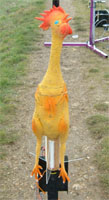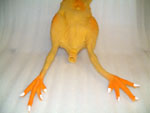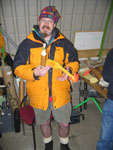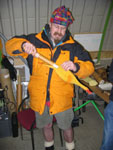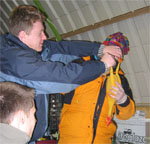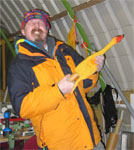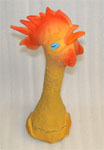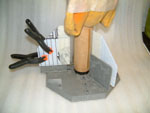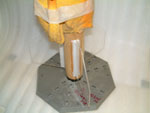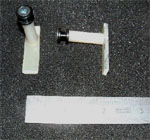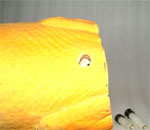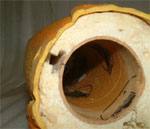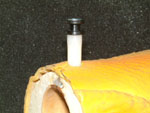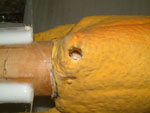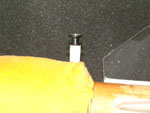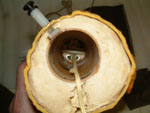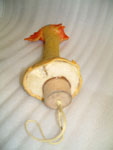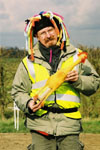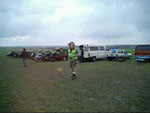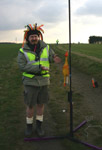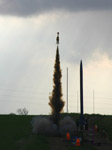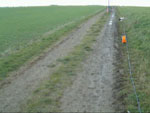| Manufacturer: | Scratch |
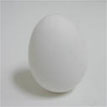
|
Which came first? The Egg? The Chicken? Or..... The Rocket! |

|
|
The Tale of Egberto
Guismonte - The Rubber Chicken Rocket
|
||
| PARTS LIST:
|
ADHESIVES: |
|
| Its all Chris Eilbeck's fault he came up with this idea to fly some rubber chickens at the m.a.r.s. Brass Balls launch. His was to be called Keith. Well it seemed like a good idea at the time. I hadn't originally planned to enter it for Descon so I dont have a lot of construction details for the early stages suffice to say " First catch your chicken..." I got mine from the Silly Jokes Online Store. |
||
The Chicken has landed |

|
| A couple of days later and I had a box full of rubber chickeny goodness. I had decided this chicken had to go with a whoosh which meant a 38mm motor mount and a Cesaroni Pro38 motor as Aerotech motors are as rare as hen's teeth over here in the UK. |
Chicken Stuffing |
|
| Having aquired my new bird the next question had to be how to fit the motor. It wasnt difficult to imagine where it had to go just how to go about putting it there. I started by removing the squeaker fitted to the chickens aft vent. | |
| The next step was to take a piece of 38mm motor mount tube and offer it up to the chicken's bottom. I drew a line around the tube and then cut out the rubber with a pair of sharp scissors. I emphasise the sharp as chicken rubber it quite resiliant and difficult to cut. A bit of trimming with a scalpel and I had an even tight fit. I fitted the motor mount in to the chicken and pushed it up until it was in the neck of the chicken as far as it would go. I then offered up a Pro38 1 Grain casing to get an idea how far the motor mount would have to hang out the back of the chicken. I figured that the tube within the body of the chicken would be adequate for the recovery system as long as the majority of the motor was outside the body. I added around 10mm to give a bit of space for motor retention below the fins and cut the motor mount tube to length. | |
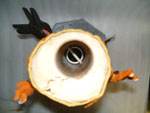
|
In the past I have used a piece of 1/4" fibre glass rod as a mounting point for the recovery harness. I drilled a hole across the tube above where the end of the motor would go, cut the fibreglass rod to length glued and filleted it inside the tube and the filed and sanded the end of the rod smooth on the outside of the tube. |
| With the motor mount trimmed it was time to make the "nose cone" fitting. Now things get a bit vauge here and I will have to leave the detail as an exercise for the student. The idea was to make something from a 38mm coupler tube with some space in it which could accept some beak weight. I rummaged and came up with a selection of Estes bits and bobs. A bit of sanded centering ring here and a bit of glue there and I had a part that would fit in to the neck of the motor mount tube. The only evidence I have of this is in this picture sequence. | |
| With the nose piece made it was time to get foamin'. My plan, which proved rather unsuccessful, was to fit the nose piece to the top of the motor tube using masking tape to hold it in place. Pour in a quantity of two part foam to the rubber chicken carcass. Jam the tube assembly up the chicken and wait for the foam to expand and set. Fixing the whole thing in place. As the join between the nose piece and the motor tube were flush at the top of the tube and the tube should fit snuggly in to the chickens rubbery neck I reasoned that, once set, I would be able to cut through the rubber and seperate the now foamed on head and nose piece from the foamed in motor tube and chicken body. The masking tape should have held the nose piece in place and sealed it from foamy ingress. | |
| There lies my error. That two part foam can build up a fair pressure if you contain it. With the foam mixed and poured in I jamed in the tube assembly. I wiggled and tipped things around to get a even distribution of liquid foam around the insides then settled down to hold it all in place. The foam expanded and started to push. It was quite a fight,and quite a sight as I struggled with my fowl. In time I triumphed, or so I thought, and the foam set with the tube where I thought it should be and a reasonably firm chicken (even if it's head had swollen in a rather disturbing fashion). | |
| Time to make a quick cut and "off with its head". First cut through where I thought I had to cut and the head refused to budge. A spell head scratching, cursing, asking others for guidance and being told "you didnt want to do it like that" later and an second calculated cut was made. This time the head came off in my hand. Some modification and fettling and I had a useable head / beak / nose cone. The reason for the cut point moving was that the pressure of the expanding foam had forced the inner nose piece back down the inside of the motor mount. The second cut was measured from the position of the aft end of the nose piece relative to the back end of the motor tube. With the length of the coupler used for the nose piece know it was possible to work out where the front of it should be. Measure along the outside of the chicken and cut through. | |
Beaky |
|
| Finally I had to add some beak weight and the beak retention end of the recovery harness.. A loaded single grain Pro38 was fitted to the rear and then lead shot was added to the hollowed out nose piece until the CofG was agreeably forward. The lead shot was mixed with 5 minute epoxy to make a nice batch of rocket caviar and was poured in and left to set. A 38mm plywood coupler bulkhead had a single approx 5mm hole drilled through it. A length of tubular kevlar was folded in half a had a figure of 8 knot tied with the two free ends held together to form a loop. This was threaded through a 5mm washer. The knot was large enough that it wouldnt pull through the washer. The loop was then pulled through the bulkhead and the bulkhead glued in to the back of the nose piece with epoxy. | |
 |
 |
